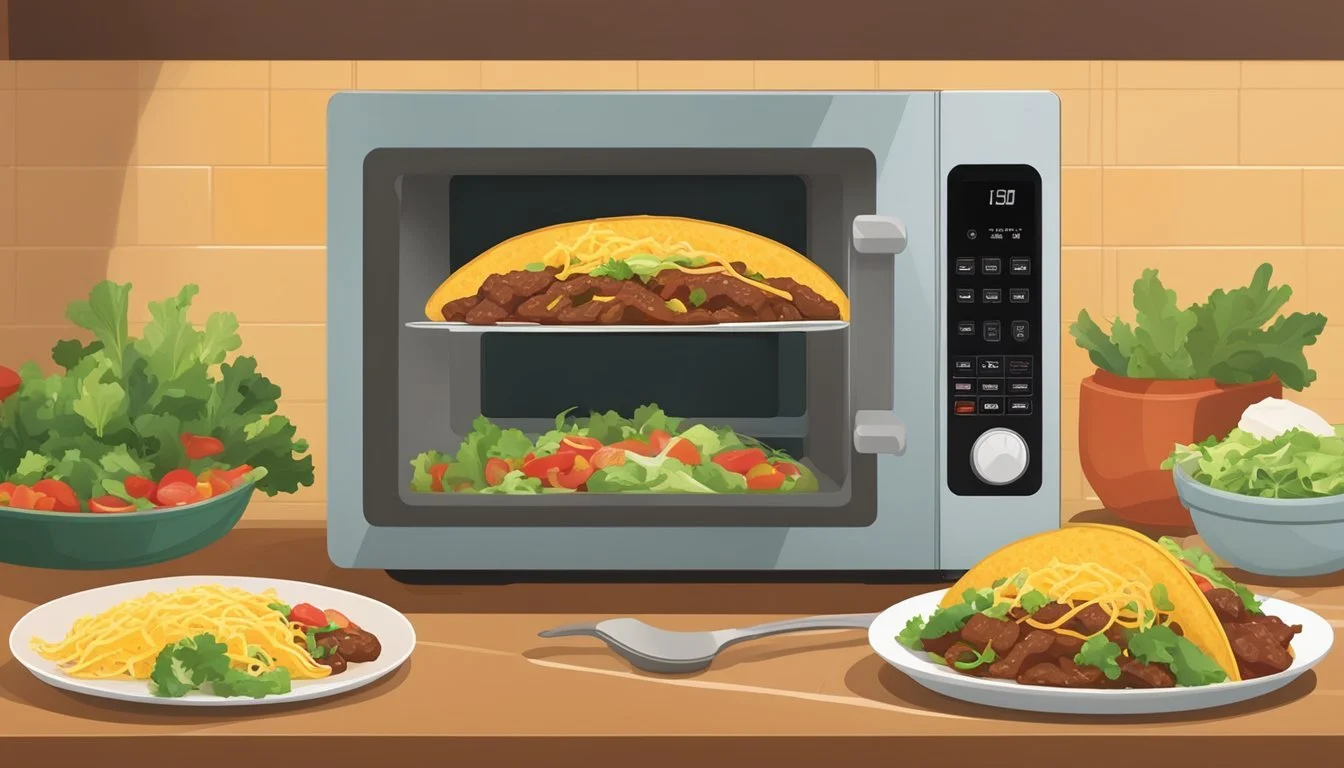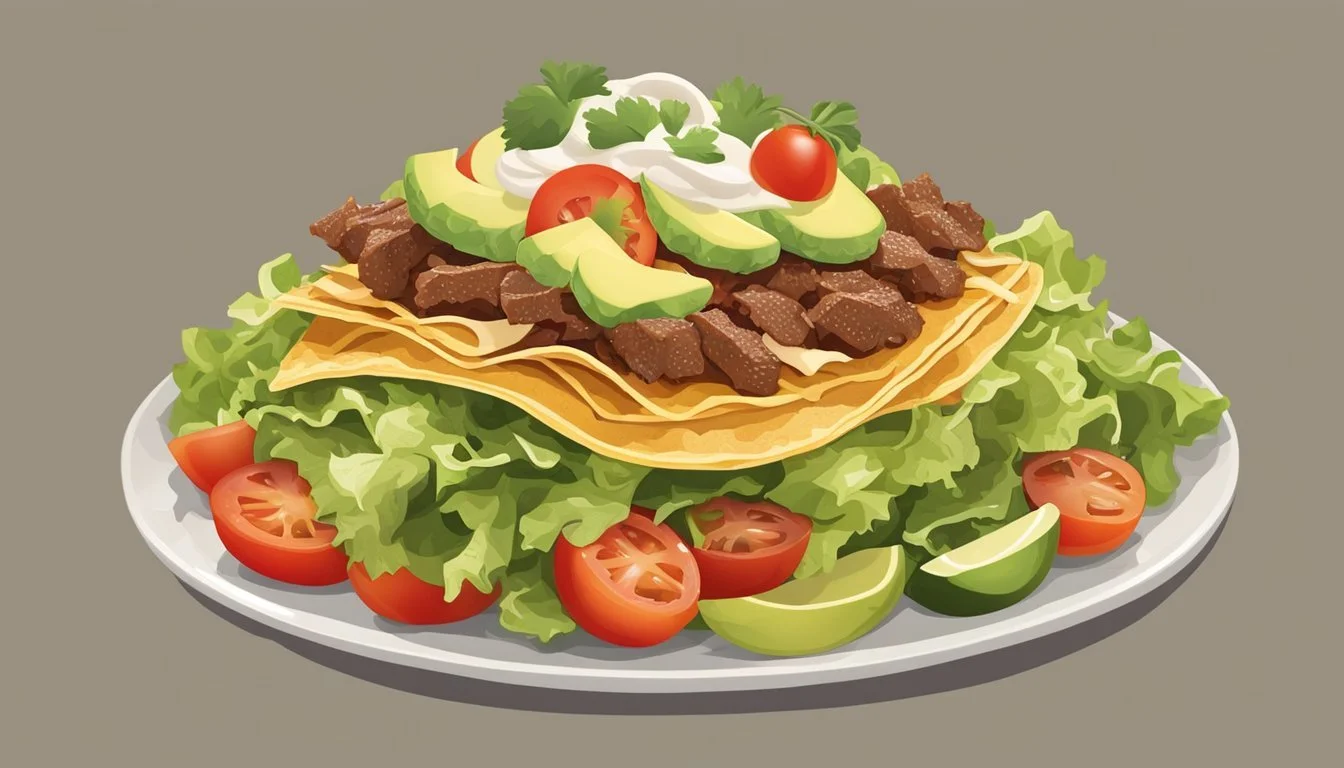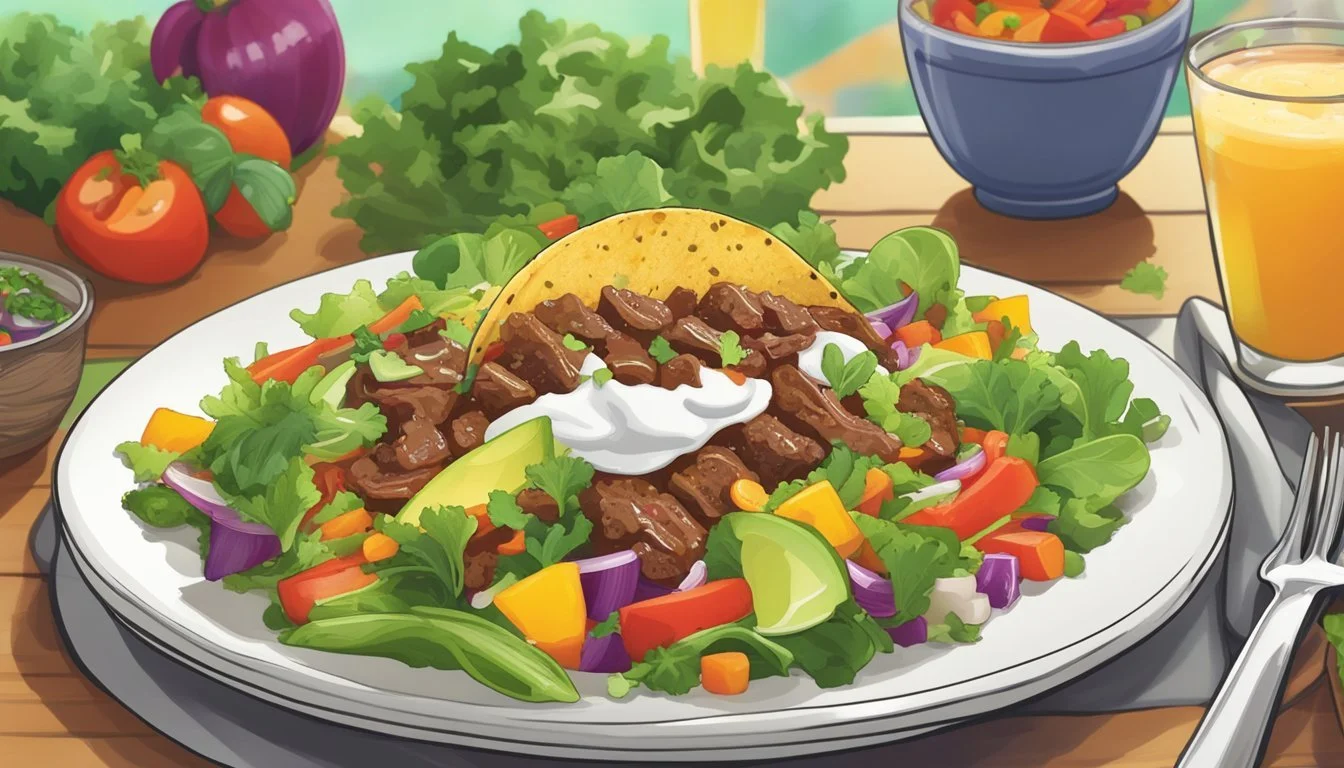Best Way to Reheat a Beef Taco Salad
Ensuring Crisp Greens Every Time
Reheating a beef (What wine goes well with beef?) taco salad requires careful consideration to maintain the vibrancy and texture of the greens while warming up the beef. It's no simple feat: the contrasting elements of a cold, crisp salad and warm, savory beef mean that combining them after reheating needs to be done thoughtfully. Satisfying the craving for that perfect bite of hearty meat and fresh salad necessitates a reheating method that warms the beef without compromising the freshness of the greens.
One optimal approach is to separate the components of the taco salad. The beef should be reheated on its own, so that no excess heat wilts the greens. A skillet over medium heat proves to be an excellent choice for warming the beef effectively. Adding a small amount of water or broth can keep the beef moist. Once it’s thoroughly heated, the beef can be allowed to rest for a short duration to prevent the residual heat from affecting the greens.
The greens and other cold salad components should be kept chilled until the moment of serving. The key is to combine the warmed beef and the cold salad just before eating, ensuring a delicious and texturally balanced bite. The beef’s warmth will be just enough to slightly soften the greens, providing a pleasant contrast without wilting. This method secures the integrity of each element of the taco salad, promising a dish that is as enjoyable as it is when freshly made.
Understanding the Components of a Taco Salad
A taco salad is a dish that combines the flavors of a traditional taco in a bowl format, often incorporating a mix of both cold and hot elements. Carefully reheating certain components, while preserving the integrity of the fresh ingredients is crucial.
Greens and Vegetables
The base of any taco salad consists of lettuce and an assortment of vegetables like tomato and other fresh options. Common choices include:
Romaine or iceberg lettuce for crunch
Spinach for a nutrient boost
Diced tomatoes
Sliced avocados or guacamole
Chopped onions
Jalapenos or bell peppers for a mild to spicy kick
These ingredients should remain raw to maintain their texture and nutritional value.
Taco Meat and Proteins
Protein is what gives a taco salad its substantial nature. Common taco meats include:
Ground beef: seasoned with taco spices
Chicken: usually shredded or diced
Pork: less common, but pulled pork is a flavorful option
Beans: black or pinto beans are popular vegetarian protein choices
Taco meat should be reheated to a safe temperature without drying it out, whereas beans might just need a quick warm-up.
Dressings and Wet Ingredients
The dressings and wet ingredients add flavor and moisture but should be handled with care to avoid a soggy salad:
Creamy dressings like ranch or a spiced-up sour cream
Salsa or pico de gallo
Lime juice for a zesty kick
These should ideally be added right before serving to maintain the crispness of the other components.
Taco Shells and Tortillas
Crunchy elements such as taco shells or tortilla strips provide a satisfying textural contrast. They can be:
Crushed taco shells
Baked or fried tortilla strips
Whole tortillas, warmed up and served on the side
Taco shells and tortilla pieces should be kept at room temperature and added just before serving to ensure they retain their crunch.
Preparation Before Reheating
Before one attempts to reheat a beef taco salad, it's crucial to prepare the ingredients properly to ensure the integrity of the flavors and textures, especially the freshness of the greens.
Separating Ingredients
Leftovers should be deconstructed with care. The key to a successfully reheated beef taco salad lies in the separation of ingredients. One should place the beef taco meat in a separate container from the greens to avoid sogginess. Additionally, taco shells or any crunchy elements, like tortilla chips, need to remain apart to maintain their crispness upon reheating.
Proper Storage Techniques
Proper storage is essential for preserving the quality of leftover taco salad components:
Beef taco meat: Store in an airtight container and refrigerate.
Greens: To prevent wilting, one should lightly wrap them in paper towels, which absorb excess moisture, and then place them in a breathable container in the crisper section of the refrigerator.
Taco shells and fillings: Keep them dry and sealed tightly. If shells are soft, wrapping them in foil before refrigerating can help them retain moisture without becoming too soggy.
Reheating Techniques
When reheating a beef taco salad, it is crucial to maintain the meat's flavor and texture without wilting the greens. Several methods are available, each suited to different preferences and equipment availability.
Oven Reheating
For oven reheating, preheat the oven to a low temperature to avoid cooking the meat further. Place the beef in an oven-safe dish and cover loosely with aluminum foil to retain moisture. Reheat at 250-300°F for about 10-15 minutes. This method is not recommended for the greens, which should be kept fresh and added after reheating the meat.
Stovetop Reheating
Reheating taco meat on the stove involves using a skillet. Place a non-stick pan over medium heat and lightly oil it. Add the taco meat, stirring occasionally to ensure even heating and to prevent burning. If necessary, add a splash of water or beef broth to keep the meat moist. Once the meat is warmed through, it can be added back to the salad. Skillets should not be used for reheating the salad greens.
Microwave Reheating
Using a microwave is a quick method to reheat taco meat. Separate the meat from the salad greens and place it in a microwave-safe dish. Cover it with a damp paper towel to maintain the meat's moisture, and heat on high in short intervals, stirring between each, until adequately warmed. This method is convenient but can result in uneven reheating and is not suitable for lettuce or other salad components.
Using an Air Fryer
To reheat tacos in an air fryer, preheat the air fryer to 350°F. Place the taco meat in the air fryer basket, ensuring that it's spread out for even reheating. The process typically takes just a few minutes. One must monitor closely to avoid overcooking. As with other methods, the air fryer should not be used for the greens, which are best when fresh.
Assembling the Reheated Taco Salad
Successfully reheating a beef taco salad involves maintaining the freshness of ingredients while ensuring the warm components are heated properly. Layering plays a critical role to ensure every bite has the perfect balance of warmth, texture, and freshness.
Layering the Warm Ingredients
The foundation of a taco salad is built upon the warm ingredients. They begin by reheating the beef separately to avoid drying it out, typically in a skillet with a touch of oil and a splash of water or broth to retain moisture. Once thoroughly heated, they spread the beef at the bottom of the serving dish. Taco shells or tortillas can be heated in an oven or microwave until they are crisp, and then broken into bite-sized pieces to be scattered over the beef.
Adding Fresh Components
After the warm elements are in place, they introduce the fresh components to the salad. Lettuce is layered on top of the meat to prevent it from wilting. Fresh salsa, diced tomatoes, and a dollop of sour cream add flavor without overwhelming the greens. Cheese is sprinkled over the salad, allowing the residual heat to gently melt it. Finally, they garnish with spoonfuls of guacamole, adding a creamy texture and rich flavor to the dish.
Additional Tips and Tricks
When reheating a beef taco salad, it is crucial to maintain the integrity of the greens and enhance the flavors that may have dulled in storage. These strategies focus on texture and taste preservation for optimal enjoyment.
Avoiding Soggy Salad
To prevent the salad from becoming soggy, one should reheat the beef separately and allow it to cool slightly before combining it with the lettuce and salad components. The meat can be gently warmed up in a skillet with a splash of beef broth to maintain moisture without wetness that could wilt the greens. It is advisable to store components like lettuce, cheese, sour cream, and guacamole separately from the leftover tacos or fillings. This practice retains freshness and separates moisture-prone ingredients from the ones that stay crisp.
Enhancing Flavor After Reheating
Reheated beef taco salad may need a flavor boost. Adding a pinch of fresh spices or herbs can revitalize the taste. A light squeeze of lime juice over the reheated beef can brighten the flavors. Moreover, one can consider mixing in fresh toppings like diced tomatoes or a small dollop of guacamole after reheating to rejuvenate the leftovers' appeal and introduce a fresh element to the salad.
Fresh Toppings Purpose Lime Juice Adds zest and revives flavors Fresh Herbs Invigorates the dish with a green note Diced Tomatoes Introduces juiciness and freshness Dollop of Guacamole Offers creaminess and rich taste
Serving and Presentation
One should assemble the beef taco salad just before serving. Begin with a bed of crisp lettuce, followed by the warmed beef and any additional leftover fillings, like black beans or corn. Cold items such as sour cream and cheese should be added on top to maintain temperature contrast. Serve the salad in a dish that showcases the layers and colors, proving that leftovers can be just as appetizing as freshly made meals.
Layer 1: Crisp lettuce
Layer 2: Warm beef
Layer 3: Additional toppings (beans, corn)
Layer 4: Cold ingredients (sour cream, cheese)
Safety and Food Quality
In reheating beef taco salad, food safety and maintaining quality are paramount. Consumers must consider the internal temperature to avoid bacterial growth and practice proper storage to maximize the shelf life and freshness of ingredients, thereby reducing food waste.
Monitoring Internal Temperature
To ensure safety, the reheated beef should reach an internal temperature of at least 165°F. A food thermometer can be used to check this temperature, ideally at the center of the meat. It’s important that the beef is heated thoroughly, but the greens should be kept separate during reheating to avoid wilting.
Correct Temperature Check: Use food thermometer
Center of beef: 165°F
Maximizing Shelf Life
Proper storage extends a meal's freshness. The ingredients for a taco salad should be stored separately. Refrigeration is crucial, with cooked beef stored below 40°F and ideally used within 3-4 days.
Storage Temperatures and Tips:
Beef: Store below 40°F
Greens and toppings: Store in separate airtight containers
Shelf Life: Consume beef within 3-4 days
Meal prep can be beneficial, as one can allocate portions of the salad for future use, reducing food waste while keeping track of ingredient freshness.
FAQs About Reheating Taco Salad
Q: Can I reheat leftover taco meat without drying it out?
A: Yes, one can reheat taco meat gently on the stove by adding a splash of water or beef broth to keep the meat moist. Stir frequently to distribute the heat evenly.
Q: What's the best way to store taco meat for reheating later?
A: Store taco meat in an airtight container in the refrigerator. For longer storage, one may freeze it, ensuring it's tightly sealed.
Q: How do I prevent greens from wilting when reheating a beef taco salad?
A: When reheating, remove the greens and only heat the beef and toppings that require warming. Add greens after reheating to maintain their crispness.
Q: Can I freeze my leftover taco meat?
A: Leftover taco meat can be frozen. Before freezing, cool it down and place it in a freezer-safe bag or container. Use within 3 months for best quality.
Q: How to reheat taco meat from frozen?
A: Reheat frozen taco meat by thawing it in the refrigerator first. Once thawed, reheat gently on the stove with a little added liquid to prevent drying.
Conclusion
Reheating a beef taco salad requires attention to detail to ensure the greens remain crisp and the beef flavorful. One should separate beef and greens, reheating only the necessary components. To maintain the quality of the beef:
Heat a skillet over medium heat, add a slight drizzle of oil, and warm the beef, stirring occasionally.
Introduce a splash of water or broth if dryness occurs.
For variations in the salad, such as beans or cheese, use the microwave:
Beans: 1 minute on High, stirring halfway through.
Cheese: Briefly, just until melted.
To keep the greens and other fresh elements vibrant, combine them with the warmed ingredients right before serving. This method preserves texture and maximizes flavor. It's important to find a balance that keeps the crunch of the greens and the tenderness of the beef.
For the best result, the recipe should be adapted to include the reheating process as a final step, ensuring that each element retains its integrity. This technique will guarantee that the beef taco salad resembles its freshly-prepared counterpart.
By utilizing these steps, one achieves a harmoniously reheated beef taco salad without compromising on quality or taste.








